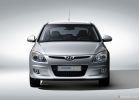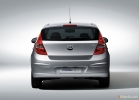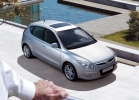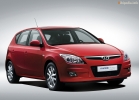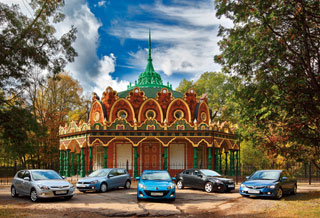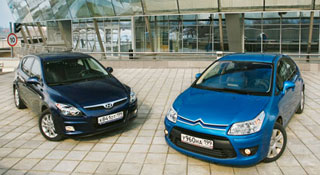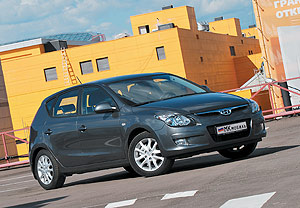Hyundai I30 test drive since 2007 hatchback
Debt good turn deserves another
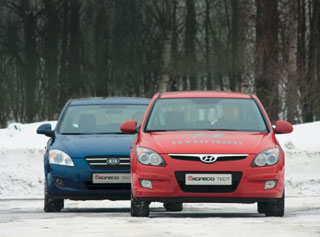 Kia Ceed. Price: from 487 492 rubles. On sale: since 2007
Kia Ceed. Price: from 487 492 rubles. On sale: since 2007 Hyundai i30. Price: from 530 900 rub. On sale: since 2009
At one time, when Kia only became part of Hyundai, the head of the company's development department announced a reduction in the number of basic platforms, which will reduce the time and cost of the development and production of new cars. The latter allowed KIA not only without much loss to get out of the financial crisis of 1998, but also to bring an enviable number of new models to the market. Today Kia returns the debt: the novelty of our market Hyundai i30 uses a platform from Kia Cee`d
Test pillets
Oleg Kalaushin, 39 years old, automobile journalist, driving experience 21 years old, personal car - Renault Logan
Igor Kuznetsov, 47 years old, automobile journalist, driving experience for 20 years, personal car - Nissan Qashqai
When both cars are nearby, initially it seems that this is the same car, only before and after restyling. It is immediately obvious that the Hyundai i30 inherited not only the platform from Cee`d, but also the entire body architecture. It is enough to look at the profiles of cars, and their kinship will be given out the roof line, and the rear stand with a small triangular window, and even the shape and location of the gas tank hatch. There is one more common feature: the shape of the hood is almost the same, in any case, the rib of stiffness, that the first, in the second, is in one place and equally smoothly goes into the front stand. Looking ahead somewhat, let's say that what is under the hood is also exactly the same.
Both have the same 1.6 -lover 122 -horsepower engine in the engine compartment, the same automatic gearbox, and even the battery of one container. The architecture of the motor compartment did not allow one car from another in terms of the front design, in connection with which they differ only in the form of a head optics and a bumper design. The latter at CEE`D and i30 ends from below with a rubberized skirt, which with such a significant overhang is very helpful. In serious way, cars differ only when examined from the rear. A more fresh i30 promotes much more modern trends, and therefore looks more interesting. But no more, because otherwise it does not actually differ from Cee`d. And in some ways he is inferior to him. Firstly, the image of Kia, in our opinion, is more holistic (it does not go against the general appearance of the car), and secondly, with the same trunk volumes with the Hyundai, Cee`d itself is still more. The latter is not
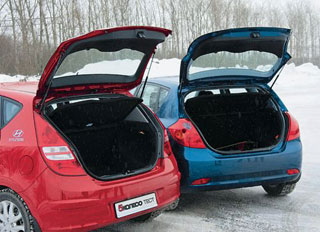 it will slow down to affect when you, say, will begin to transport any large-sized thing. And to do this, on the first, in the second car, you can easily. With folded seats of the second row, the volume of the trunk in both cases increases to 1300 liters in CEE`D and to 1250 liters of i30.
it will slow down to affect when you, say, will begin to transport any large-sized thing. And to do this, on the first, in the second car, you can easily. With folded seats of the second row, the volume of the trunk in both cases increases to 1300 liters in CEE`D and to 1250 liters of i30. The understanding that these are still different cars come only when you find yourself behind the wheel. Despite the general genes, the designers still tried to make them even from the inside, but still favorably differed from each other in order to avoid direct competition within one corporation. Understanding that in the obviously limited framework of the platform, the internal volume will not be able to radically change anything, they gave free rein to fantasy. As a result, the interior of the i30 is much youth conservative against its background Cee`d. Moreover, it touched this literally everything, from the instrument shield to the upholstery of the doors. In this regard, ergonomics also changed, although not much. For example, in the i30, only the driver can manage the central castle (the key is located on the driver's armrest), while the front passenger can easily use this function in Cee`d. In Kia, it is also more convenient to use the key to select a route computer. Its display is located in the upper part of the central console, and in the same place, under it, in a convenient access control, the key controls it. In order to extract the necessary information from the bowels of the smart machine, in the i30 you have to crash and press the key behind the wheel, in the immediate vicinity of the instrument panel. Little things, of course, but this does not add convenience.
We have already mentioned that the cars are aggregated by the same engines and gearboxes, so we did not notice any special differences in the behavior of cars on the road. However, one feature is still worth noting: the suspension setup is what Hyundai decided to distinguish from Kia. The latter, for the sake of comfort and endurance, although slightly, but softer.
It remains to add that KIA and Hyundai guarantee is five years or 150,000 km of run. Well, another plus in favor ...
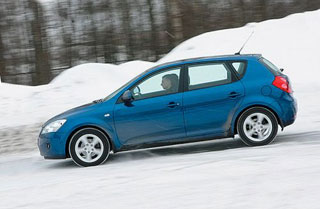 Kia Ceed
Kia Ceed Ceed is nothing more than an abbreviation that denotes that this car is in C-class, and E and D, written through the apostrophe, offer it to European Design. CEED, according to Koreans, can fully compete with cars such as VW Golf, Ford Focus, Mazda3 and Toyota Corolla. Which, however, prove his sales.
Driving
A fairly dynamic and predicted car with sharp steering control and excellent brakes.
Salon
Thoughtful ergonomics, high quality of finishing materials. A roomy trunk.
Comfort
Multiper, air conditioning and many more of what affects comfort is present in the car.
Security
Six airbags, active headrests, ABS and ESP.
Price
Attractive in its segment.
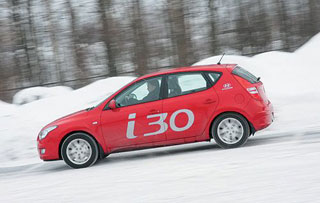 Hyundai i30
Hyundai i30 It was developed at the Hyundai Design and Technical Center in Rüsselsheim specifically for the European market. This car became the second Hyundai model, created taking into account the preferences of European buyers, and the first Hyundai car, which uses a new, alphanumeric principle of designation.
Driving
Designed for Europe, I30 and travels like a European. Of the features, only slightly thoughtful work of a four -speed automatic transmission can be noted.
Salon
Convenient and cute, but the location of some keys cannot be recognized as ergonomic.
Comfort
Convenient seats, a good standard audio system, good sound insulation. There are no complaints about the climatic system.
Security
Six airbags, active headrests, ABS, ESP.
Price
At the level of competitors.
Our verdict
So what to choose? It seems to us that the potential owner in this case will have to be guided exclusively by the impulse of the soul. Both Hyundai i30, and Kia Cee`d are worthy and, most importantly, absolutely self -sufficient cars. Both were designed with a sink to Europe, and I must say that the engineers successfully coped with this task. The only thing that, perhaps, should not be forgotten, in the secondary market Hyundai was always more expensive than Kia. However, is it worth thinking about the future, if there is an opportunity to enjoy the present?
Author: Oleg Kalaushin
Photo: Igor Kuznetsov
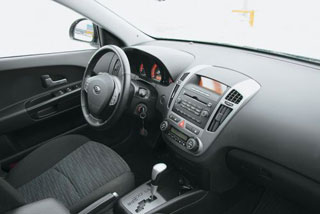
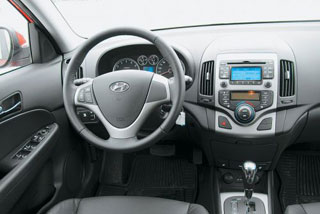
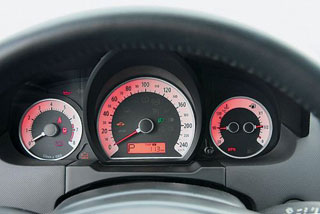
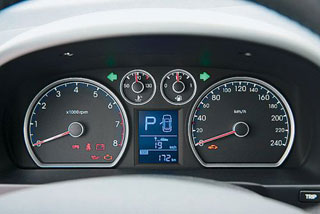
A source: Magazine 5 wheel [March 2009]
Hyundai I30 crash tests since 2007
Hyundai I30 test drives since 2007
Hyundai I30 crash test since 2007
Krassh Test: Detailed Information34%
Driver and passengers
14%
Pedestrians
38%
Children-passengers

